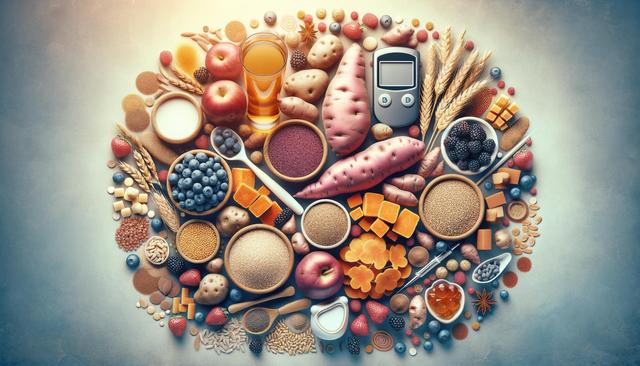Top Carbs Diabetics Can Safely Eat
Explore top carbs that diabetics can safely eat while managing their blood sugar levels. Learn how to incorporate whole grains, legumes, and vegetables into your diet, providing energy without compromising your health. Make informed choices for a balanced lifestyle.

Understanding Carbohydrates and Diabetes
Carbohydrates are often misunderstood in the context of diabetes. While it’s true that carbs have a direct impact on blood sugar levels, not all carbs are created equal. The key lies in choosing complex carbohydrates that are high in fiber and nutrients. These types of carbs are digested more slowly, leading to a gradual rise in blood glucose rather than a spike. Understanding the glycemic index (GI) of foods is helpful; foods with a low GI are generally better choices for those managing diabetes. Complex carbs also offer sustained energy and support overall health when balanced with proteins and healthy fats.
Simple carbohydrates, such as those found in sugary drinks, candies, and white bread, are quickly digested and can cause rapid increases in blood sugar. These should be limited, especially for people with diabetes. On the other hand, whole foods like vegetables, legumes, and whole grains provide fiber, which slows digestion and promotes a more stable blood sugar response. Knowing the difference between these types can help individuals make better dietary choices that support long-term health and glucose control.
Whole Grains for Lasting Energy
Whole grains are an excellent carbohydrate source for individuals with diabetes. Unlike refined grains, whole grains contain all components of the grain kernel — the bran, germ, and endosperm — which makes them richer in fiber, vitamins, and minerals. The fiber content is particularly important, as it helps slow the absorption of glucose and promotes a feeling of fullness, reducing the urge for unhealthy snacking.
Some good whole grain options include:
- Oats
- Quinoa
- Barley
- Brown rice
- Whole wheat pasta
These grains can be used in a variety of meals, from breakfast porridges to hearty dinner bowls. When shopping, it’s helpful to look for labels that say “100% whole grain” to ensure you’re getting the full health benefits. Incorporating these into your diet can make a meaningful difference in managing blood sugar levels while offering a satisfying and nutritious way to enjoy carbs.
Legumes: Protein-Packed Carbs
Legumes, which include beans, lentils, and peas, are an outstanding carbohydrate option for diabetes management. They are unique because they combine complex carbohydrates with a high protein content, which can help stabilize blood sugar levels and support muscle health. Additionally, legumes are rich in fiber, which slows digestion and helps prevent post-meal blood sugar spikes.
Popular legumes to include in a diabetic-friendly diet are:
- Chickpeas
- Black beans
- Lentils
- Kidney beans
- Split peas
These options are not only versatile but also affordable and accessible. They can be added to soups, salads, or served as a main dish. Legumes also have a low glycemic index, making them a safe choice for maintaining consistent energy throughout the day. When incorporating legumes into your meals, opt for dried or low-sodium canned varieties to limit unnecessary additives.
Vegetables Rich in Fiber and Nutrients
Non-starchy vegetables are an essential part of a diabetic diet. While vegetables do contain carbohydrates, the amount is generally low, and the fiber content helps control blood sugar levels. These vegetables are also packed with essential vitamins, minerals, and antioxidants, which support overall wellness and help reduce inflammation, a factor often associated with diabetes complications.
Some top vegetable choices include:
- Broccoli
- Cauliflower
- Spinach
- Kale
- Brussels sprouts
- Bell peppers
These vegetables can be enjoyed raw, steamed, roasted, or stir-fried with healthy oils. By filling at least half your plate with non-starchy vegetables, you can reduce the portion size of higher-carb foods and create a more balanced meal. It’s also helpful to experiment with herbs and spices to make vegetable dishes more appealing without adding sugar or unhealthy fats.
Fruits and Dairy in Moderation
Fruits and dairy products contain natural sugars, which means they need to be consumed in moderation by those with diabetes. However, their nutritional benefits — including fiber, antioxidants, and essential vitamins — make them valuable components of a balanced diet when chosen wisely. The key is to opt for whole fruits rather than fruit juices or dried fruits, which can be more concentrated in sugar and calories.
Here are some fruits that are generally well-tolerated in controlled portions:
- Berries (e.g., strawberries, blueberries)
- Apples
- Peaches
- Pears
- Oranges
In terms of dairy, plain Greek yogurt and low-fat milk can be good sources of protein and calcium. Be cautious of flavored yogurts and milk products with added sugars. Reading nutrition labels can help identify options with minimal added ingredients. Pairing fruits or dairy with a handful of nuts or a slice of whole grain toast can further reduce blood sugar spikes by balancing the macronutrient profile of the snack or meal.
Conclusion: Making Smart Carbohydrate Choices
Managing diabetes doesn’t require eliminating carbs — it requires selecting the right types in appropriate amounts. Whole grains, legumes, non-starchy vegetables, and selected fruits and dairy products can all be part of a healthy, balanced diet. By focusing on fiber-rich, nutrient-dense options and understanding how different carbs affect blood sugar, individuals can enjoy a wide variety of foods without compromising their health. Planning meals with a focus on whole, minimally processed ingredients can support long-term glucose control and overall well-being. Making smart, informed choices empowers people with diabetes to maintain energy, enjoy food, and manage their condition effectively.